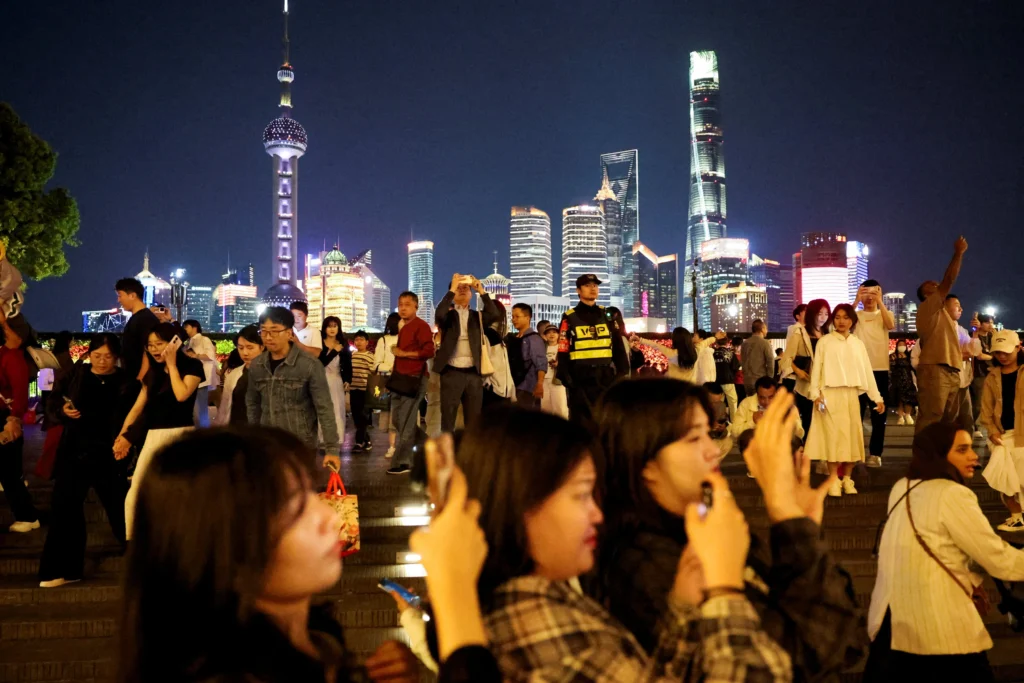A South Korean viewer, Kim Min-jun, was drawn to the sea of clouds, red cliffs, and green meadows in Chenzhou, Hunan after seeing them on a travel program—so he traveled to China this October to experience them firsthand.
His family trip happened to overlap with China’s extended National Day “Golden Week”, which ended on Wednesday. Although major scenic areas were crowded, he fully joined the festivities—attending a pumpkin party, watching fireworks, and dancing around a bonfire.
Kim said that transportation was convenient and local hospitality surpassed his expectations. He also heard Korean spoken at many attractions, and described Golden Week as feeling like an international festival.
From mist-covered mountains to centuries-old towns, destinations across the country were packed as millions traveled during one of the year’s busiest holidays, turning the week into a vivid display of both travel enthusiasm and economic momentum.
According to the Ministry of Culture and Tourism, China logged 888 million domestic trips during the eight-day holiday—which overlapped with the Mid-Autumn Festival—123 million more than the seven-day break in 2024. Domestic tourism revenue reached 809 billion yuan (about US$113.8 billion), 108 billion yuan higher than last year.
Inbound Tourism on the Rise
Easier procedures and expanded visa-free policies drove a strong rebound in inbound travel. Data from Trip.com show that top source markets included the Republic of Korea (ROK), United States, Russia, Japan, and Malaysia.
In Hunan Province, foreign visitors made about 23,000 trips, accounting for over half of local border crossings, with ROK tourists comprising 81%. Beijing welcomed 119,000 overseas arrivals (+48% year on year), and their spending climbed 54% to 1.23 billion yuan.
In Shanghai, Russian traveler Kirill Ratnikov observed that Chinese cities have become much greener, which improved his mood, and he predicted that visa-free entry would attract more Russians.
According to the National Immigration Administration (NIA), travelers from 76 countries now benefit from unilateral or mutual visa-free entry, and 55 countries are eligible for visa-free transit.
During the holiday, foreigners’ cross-border trips increased 21.6% to 1.43 million. Of these, 751,000 foreigners entered China, including 535,000 on visa-free entry, up 19.8% and 46.8% year on year, respectively, the NIA reported on Thursday.
China is also working to reduce payment and language friction for international visitors. Alipay and WeChat Pay now allow direct linking of international credit cards; AI translation tools are being deployed at airports and tourist sites; and by end-August, tax-refund stores serving foreign travelers had exceeded 10,000.
Traditional Culture Rebounds
Traditional culture became a signature feature of the holiday. In Shanghai, subway exhibits of paper-cuttings of the Moon goddess Chang’e, rabbit-shaped lanterns in an ancient town, and fabric collages at the Power Station of Art drew visitors eager to capture the perfect holiday photo.
Local visitor Zhou Xiang said that despite continuous development, the city retains its traditional charm, which is a core part of its appeal.
Trip.com added that cultural-themed products—from historic-site tours to intangible cultural heritage workshops and “China-chic” routes—saw a jump in bookings during the holiday.
In Tongling, Anhui, artisans revived the centuries-old craft of molten-iron fireworks, while Beijing hosted a week-long opera series featuring diverse local performances. Museums such as the Hubei Provincial Museum and the Shenyang Palace Museum extended evening hours to accommodate more visitors.
In late September, China launched a month-long nationwide campaign to boost cultural and tourism consumption, organizing over 29,000 events and issuing more than 480 million yuan in consumption subsidies.
According to Zhang Xiangyu, head of the Henan Academy of Cultural and Tourism Planning, tourists are shifting from passive sightseeing to active exploration. He said traditional culture is being revitalized through new expressions, becoming a key draw for travelers during the holiday.
Small Towns, Big Demand
Many travelers ventured beyond headline destinations to seek less-crowded and more authentic experiences.
The online travel platform Fliggy reported that bookings for small cities and counties surged, with some destinations surpassing 200% growth during the vacation.
Wu Nanxuan of Huaxia Baiqiang Tourism Consulting Center noted that county-level tourism is now one of the strongest growth engines in China’s travel market. He added that 18–34-year-olds account for most of this wave, and self-driving trips are especially popular with them.
As restaurants, shopping malls, and attractions filled up, the holiday unleashed consumer spending and supported the economy. According to the State Taxation Administration, daily average sales in consumer-related sectors rose 4.5% year on year during the holiday.
Cinemas also benefited: box-office revenue from Oct. 1–8 exceeded 1.83 billion yuan, powered by a lineup of domestic films.
Ming Ming, chief economist at CITIC Securities, said the results show the potential and resilience of China’s domestic consumption.
He added that consumption will remain a key growth driver, and he expects new measures aimed at deepening reform in services and strengthening consumer confidence.
Source: People’s Daily Online — “Golden Week tourism surge highlights new consumption trends in China”.
Abroad Africa AI Beijing Belt & Road BLCU BRICS China chinese CPC CSC Culture Economy education EU Guizhou Kültür Langauge movie Multipolarity Russia scholarship science Shanghai Sino Sino Turkish Sino Turkish Sino Turkish Sino Turkish Sino Turkish Studies Sino Turkish Studies Sino Turkish Studies Sino Turkish Studies space Syria Taiwan Tariff trump Turkiye Türkiye University USA Xinjiang ZJUT Çin





